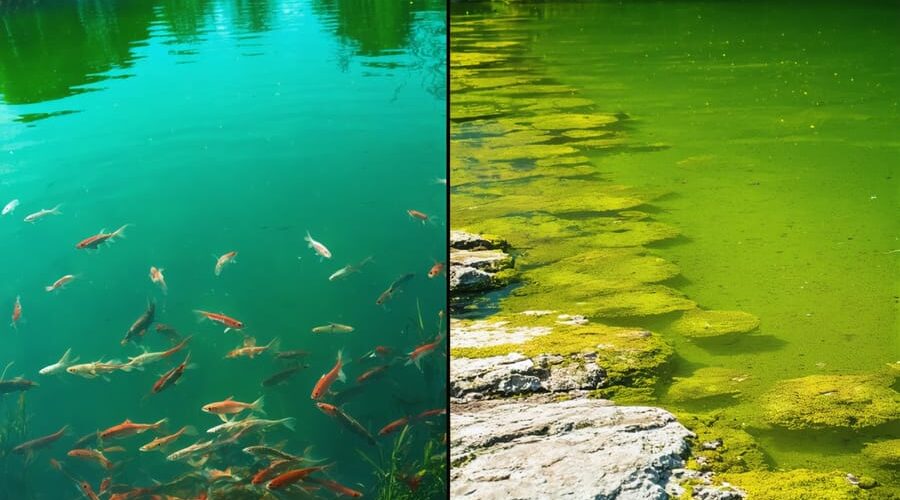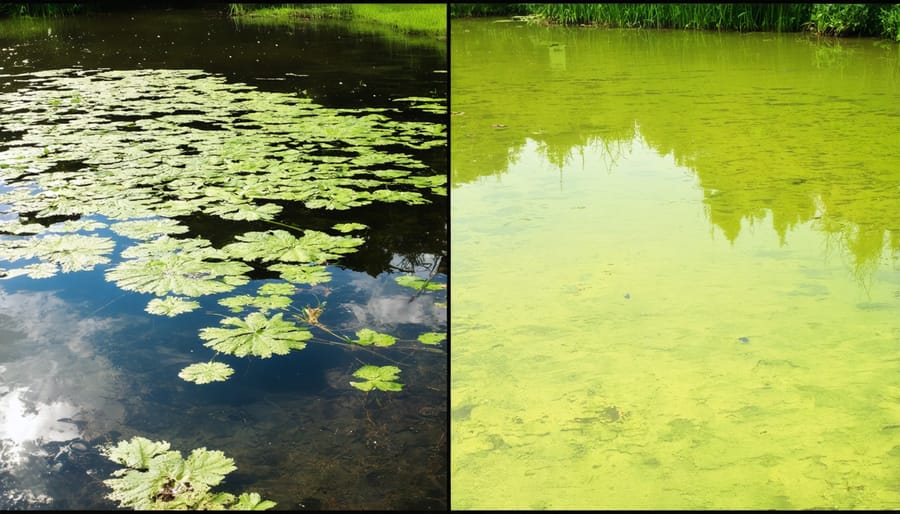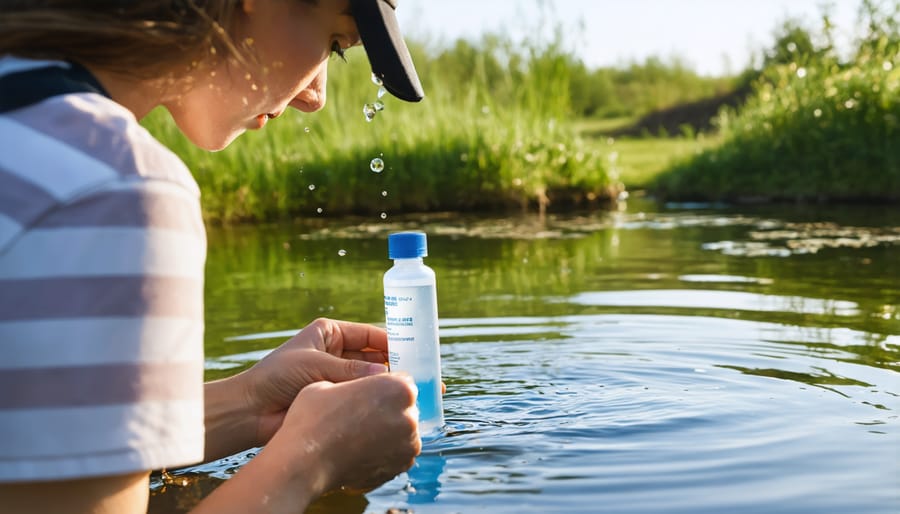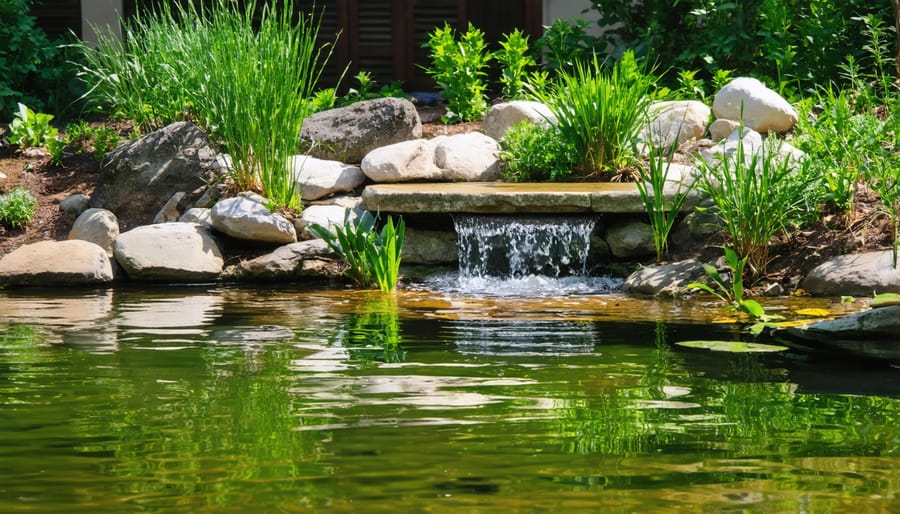
Save Your Pond: Essential Steps to Prevent and Reverse Harmful Pollution
Pond pollution threatens more than just aesthetics – it disrupts entire aquatic ecosystems and can pose serious health risks to wildlife and humans alike. Every year, thousands of residential ponds suffer from chemical runoff, excess nutrients, and organic waste accumulation, turning once-pristine waters into murky, lifeless pools. Creating a thriving pond ecosystem requires understanding both the causes and solutions to water pollution.
The good news? Most pond pollution issues can be effectively managed through proper maintenance and preventive measures. Whether you’re dealing with algal blooms, chemical contamination, or organic debris, practical solutions exist to restore and maintain your pond’s health. By implementing the right combination of filtration, beneficial bacteria, and natural barriers, pond owners can transform troubled waters into clean, balanced environments that support diverse aquatic life.
This guide explores the most common types of pond pollution, their environmental impact, and proven strategies to combat them. From simple DIY solutions to long-term management techniques, you’ll discover how to protect your pond while creating a sustainable water feature that enhances your outdoor space.

Common Sources of Pond Pollution
Natural Pollutants
While many pond owners focus on chemical pollutants, natural materials can also cause significant water quality issues. Fallen leaves, grass clippings, and other plant debris that accumulate in your pond gradually decompose, releasing excess nutrients and consuming vital oxygen in the process. This natural buildup can lead to murky water and potentially harmful conditions for your fish and plants.
Animal waste, particularly from visiting wildlife like birds and amphibians, introduces additional organic matter and nutrients into your pond ecosystem. While some wildlife activity is beneficial and adds to your pond’s natural charm, too much waste can upset the delicate balance of your water garden. Fish waste also contributes to this organic load, especially in ponds with higher fish populations.
Dead plant material from aquatic vegetation can sink to the bottom, creating a layer of organic muck that slowly breaks down. This decomposition process not only affects water clarity but can also release gases that might stress your pond inhabitants. During autumn, falling leaves can be particularly problematic if not managed properly.
To maintain a healthy balance, regular skimming of surface debris, moderate fish feeding, and occasional bottom cleaning are essential practices. Installing a pond net during fall can significantly reduce leaf accumulation, while maintaining proper filtration helps process organic waste effectively. Remember, some organic matter is natural and beneficial – the key is preventing excessive buildup.
Human-Caused Contamination
Human activities can significantly impact pond water quality, with some of the most common issues arising from everyday maintenance and landscaping practices. Fertilizer runoff from nearby lawns and gardens is a major concern, as excess nutrients flow into ponds during rainfall, leading to algae blooms and oxygen depletion. This is especially problematic in residential areas where heavy fertilizer use is common.
Chemical treatments, while sometimes necessary for pond maintenance, can become pollutants when improperly used. Over-treating with algaecides or using the wrong concentrations of water treatments can harm beneficial bacteria and disrupt the pond’s natural balance. Even common household chemicals like soap from car washing or cleaning products can find their way into ponds through surface runoff.
Improper maintenance practices also contribute to contamination. Failing to remove fallen leaves and debris allows organic matter to decompose in the water, releasing harmful nutrients. Overfeeding fish is another common mistake that leads to excess waste and decreased water quality. Some pond owners unknowingly worsen conditions by using tap water to top off their ponds without first removing chlorine.
Regular maintenance tasks like skimming, proper fish feeding, and careful chemical application can prevent most human-caused contamination. Creating buffer zones around ponds using native plants can help filter runoff before it reaches the water, while being mindful of lawn care products used in the surrounding area can significantly reduce pollution risks.
Immediate Solutions for Existing Pollution
Water Testing and Assessment
Regular water testing is your first line of defense against pond pollution. Start with a basic water testing kit that measures pH, ammonia, nitrites, and dissolved oxygen levels. These kits are readily available at garden centers and are easy to use – simply collect a water sample and follow the color-matching instructions on the test strips.
For pH, aim for a reading between 6.5 and 8.5. Ammonia and nitrite levels should be close to zero, while dissolved oxygen should stay above 6 mg/L for healthy fish. If you notice unusual readings, don’t panic! Start by checking your filter system and removing any excess debris.
Keep a simple log of your test results to track changes over time. Test weekly during warm months and monthly during cooler seasons. Remember that morning readings are most accurate, as oxygen levels naturally fluctuate throughout the day.
For more complex issues, consider having your water professionally tested. Many local extension offices offer detailed water analysis services that can detect problems your home kit might miss.

Emergency Clean-up Methods
When faced with sudden pond pollution, quick action is essential. For chemical spills, immediately stop the source and use activated carbon to absorb contaminants. If you notice an oil slick, deploy floating absorbent pads or natural materials like hay to soak up the substance before it spreads further.
For organic pollution from excess leaves or debris, use a pond net to remove floating matter quickly. In cases of algal blooms, consider using natural pond solutions like barley straw or beneficial bacteria treatments that work within 24-48 hours.
If you spot dead fish or unusual water coloration, perform an immediate 25% water change using dechlorinated water. Keep an emergency kit handy with items like water test strips, activated carbon, and bacterial treatments for quick response.
For sediment pollution after heavy rain, use a pond vacuum to remove settled debris and install temporary barriers to prevent further runoff. Remember to document the incident and identify the pollution source to prevent future occurrences. These quick fixes should be followed by long-term solutions to maintain optimal pond health.
Safe Fish and Plant Care During Treatment
When treating your pond for pollution, it’s crucial to protect your fish and plants throughout the process. Start by gradually moving fish to a temporary holding tank with water from the pond, ensuring the temperature matches to prevent shock. Add an air stone to maintain proper oxygen levels in the holding tank.
For plants, carefully remove them and place them in buckets filled with clean pond water. Gently rinse off any debris or algae, but avoid using tap water as it can harm beneficial bacteria on plant roots. Keep floating plants in shallow containers with pond water, and ensure marginal plants remain partially submerged.
During treatment, monitor your fish closely for signs of stress such as rapid breathing or unusual behavior. Check water parameters daily, including temperature, pH, and ammonia levels. If using chemical treatments, always follow dosage instructions precisely and choose products specifically labeled as safe for aquatic life.
Once pollution levels have improved, reintroduce fish and plants gradually. Start by floating fish in bags containing their temporary tank water for 20 minutes to acclimate them to the treated pond water. Return plants to their original positions, ensuring they’re properly anchored and at the correct depth.
Long-Term Prevention Strategies
Natural Filtration Systems
Nature has perfected water purification over millions of years, and we can harness these same processes in our ponds. Natural pond plants for filtration work alongside beneficial bacteria to create a self-sustaining ecosystem that keeps your water clean and healthy.
Water lilies and floating plants like duckweed act as natural filters by absorbing excess nutrients that would otherwise feed algae. These plants shade the water, reducing sunlight penetration and limiting algae growth. Submerged plants, such as hornwort and anacharis, oxygenate the water while removing harmful compounds through their leaves and stems.
Marginal plants around your pond’s edge, including cattails and rushes, create a buffer zone that catches debris and filters runoff before it enters the water. Their root systems host beneficial bacteria that break down organic waste and convert harmful ammonia into safer compounds.
Speaking of bacteria, these microscopic helpers are the unsung heroes of natural filtration. They form biofilms on plants, rocks, and filter media, creating living water purifiers that work 24/7. To encourage healthy bacterial colonies, avoid harsh chemicals and provide plenty of surface area through rocks and plant materials.
For best results, aim to cover about 60% of your pond’s surface with various plants. This balance allows for proper circulation while maintaining enough plant life to filter effectively. Remember to maintain your natural filtering system by removing dead plant material and occasionally thinning out excessive growth to prevent overcrowding.

Protective Landscaping
Creating a protective landscape around your pond is one of the most effective ways to prevent pollution and maintain healthy water quality. Start by establishing a buffer zone of native plants around the pond’s edge, extending at least 3-5 feet from the water. These plants act as natural filters, catching debris and absorbing excess nutrients before they reach the water.
Consider creating swales or gentle depressions in the landscape that direct water flow away from the pond. These natural channels can be lined with gravel and water-loving plants to slow down and filter runoff during heavy rains. Position these features strategically on slopes leading to your pond.
Ground cover plants are your best friends in preventing soil erosion. Plant dense, low-growing vegetation on banks and slopes around your pond. Not only do they hold soil in place, but they also create a beautiful, natural look while doing their protective work.
Add a rain garden in areas where runoff tends to collect. These specially designed gardens feature deep-rooted plants that excel at filtering pollutants from water before it reaches your pond. Popular choices include iris, rushes, and sedges.
For areas with heavy foot traffic, install permeable pathways using materials like gravel or stepping stones set in sand. This allows water to seep slowly into the ground rather than rushing directly into your pond. Remember to maintain these landscape features regularly by removing debris and replacing plants as needed to ensure they continue protecting your pond effectively.
Maintenance Schedule
To keep your pond healthy and pollution-free, following a regular maintenance schedule is essential. Think of it as giving your pond a regular health check-up! Here’s a simple timeline of tasks to prevent pollution buildup and maintain crystal-clear water.
Daily Tasks:
– Remove any visible debris like fallen leaves or twigs
– Check for signs of algae growth
– Monitor fish behavior and water clarity
– Ensure pumps and filters are running smoothly
Weekly Tasks:
– Test water parameters (pH, ammonia, nitrates)
– Clean pump pre-filters
– Remove dead plant material
– Check for any unusual odors or water discoloration
Monthly Tasks:
– Deep clean filtration systems
– Trim aquatic plants
– Check UV clarifier (if installed)
– Inspect liner for damage
– Remove accumulated bottom sludge
Seasonal Tasks:
– Spring: Remove winter debris and restart filtration
– Summer: Maintain proper water levels and aeration
– Fall: Install nets to catch falling leaves
– Winter: Reduce feeding and remove dead vegetation
Following these sustainable pond maintenance practices not only prevents pollution but also saves time and money in the long run. Remember to keep a maintenance log to track changes and spot potential issues before they become serious problems. By staying consistent with these tasks, you’ll create a healthier environment for your aquatic ecosystem and reduce the likelihood of pollution-related problems.
Maintaining a healthy pond is an ongoing journey that requires attention, care, and proactive measures. As we’ve explored throughout this guide, pond pollution can arise from various sources, but the good news is that most issues are preventable with the right approach. By implementing regular maintenance routines, choosing appropriate filtration systems, and being mindful of what enters your pond, you can create a thriving aquatic ecosystem that brings joy for years to come.
Remember that prevention is always easier than cure. Simple steps like regular water testing, proper plant management, and careful fish feeding can help you avoid many common pollution problems. Stay vigilant for early warning signs such as unusual algae growth, water discoloration, or changes in fish behavior – catching issues early makes them much easier to address.
Don’t feel overwhelmed by the responsibility of pond care. Start with basic maintenance practices and gradually implement more advanced techniques as you become more comfortable. Consider joining local pond enthusiast groups or online communities where you can share experiences and learn from others.
Your pond is more than just a water feature – it’s a living ecosystem that contributes to local biodiversity and creates a peaceful retreat in your garden. By taking action against pollution and maintaining good water quality, you’re not only protecting your investment but also creating a sustainable environment for future generations to enjoy.
Let’s work together to keep our ponds clean, healthy, and beautiful!
